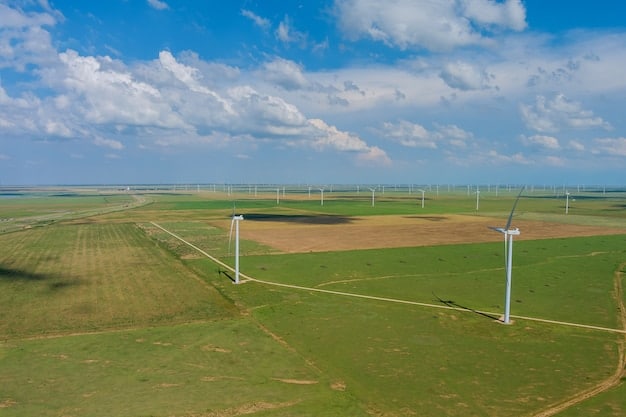US Energy Sector: Renewable Shift & Business Impact

The shift to renewable energy in the US energy sector presents both significant challenges and unparalleled opportunities for businesses, necessitating strategic adaptation and investment in sustainable practices to thrive in an evolving market.
The **US energy sector** is undergoing a profound transformation, driven by an accelerating shift towards renewable energy sources. This fundamental change is redefining operational paradigms and strategic priorities across countless industries, raising the critical question of what this transition truly means for businesses seeking growth and stability.
The evolving landscape of the US energy sector
The energy landscape in the United States is experiencing an unprecedented evolution. Historically dominated by fossil fuels, the sector is now increasingly characterized by the integration of renewable energy sources such as solar, wind, hydropower, and geothermal. This shift is not merely a technological upgrade but a fundamental reorientation driven by environmental imperatives, technological advancements, falling costs, and supportive policy frameworks.
Understanding the impetus behind this transition is crucial for any business operating within or impacted by the energy sector. Concerns over climate change, energy security, and volatile fossil fuel prices have collectively pushed governments, corporations, and consumers toward cleaner alternatives. The decreasing cost of renewable energy technologies, particularly solar photovoltaics and wind turbines, has made them economically competitive, and in many cases, cheaper than traditional energy generation.
Policy support, too, plays a pivotal role. Federal and state incentives, tax credits, and regulatory mandates are creating a favorable environment for renewable energy investment and deployment. This multifaceted push is accelerating the pace of change, from utility-scale projects to distributed energy resources on rooftops and local communities.
Key drivers of change
Several factors are converging to accelerate the transition. Technological innovation, for instance, is continuously improving the efficiency and reducing the cost of renewable energy. Advances in battery storage, smart grids, and digital energy management systems are overcoming historical intermittency challenges associated with renewables, making them more reliable and dispatchable.
- Technological Innovation: Enhanced efficiency and lower costs of solar, wind, and storage.
- Economic Competitiveness: Renewables often cheaper than new fossil fuel plants.
- Policy and Regulatory Support: Tax credits, subsidies, and clean energy mandates.
- Environmental Imperatives: Growing urgency to combat climate change and reduce emissions.
Furthermore, corporate commitment to sustainability and environmental, social, and governance (ESG) principles is driving demand for clean energy from large businesses. Many corporations are setting ambitious renewable energy targets, either by purchasing clean energy directly or investing in their own on-site generation capacity. This corporate leadership signal is reverberating through supply chains and influencing business decisions across various sectors.
The evolving landscape signifies a departure from a centralized, unidirectional energy system to a more decentralized, diversified, and intelligent grid. This paradigm shift offers both immense opportunities and considerable challenges for businesses as they navigate new market dynamics, regulatory complexities, and technological demands.
Economic ramifications for traditional energy businesses
For businesses rooted deeply in the traditional fossil fuel sector—oil and gas exploration, production, refining, and coal mining—the shift to renewable energy presents significant economic ramifications. These companies face the dual challenge of declining demand for their core products in many markets and increasing investor pressure to decarbonize their operations and diversify their portfolios.
The most direct impact is on revenue streams. As renewable energy becomes more prevalent and cost-effective, demand for fossil fuels for electricity generation in the US is diminishing. While oil and gas still hold sway in transportation and industrial processes, even these sectors are seeing increased electrification and sustainable fuel alternatives on the horizon. This necessitates a strategic pivot for many traditional energy giants.
Challenges faced by fossil fuel companies
- Stranded Assets: Risk of existing fossil fuel infrastructure becoming economically unviable.
- Decreased Demand: Reduction in consumption of coal, oil, and natural gas for power generation.
- Investment Withdrawal: Growing pressure from investors to divest from fossil fuels.
- Workforce Transition: Need to retrain or reallocate personnel from declining segments.
Moreover, the cost of capital for traditional fossil fuel projects is rising as financial institutions and investors increasingly prioritize ESG criteria. This makes it harder for these companies to secure funding for new ventures, further constraining their growth prospects in conventional areas. Many are consequently exploring new business models, investing in carbon capture technologies, or pivoting towards renewable energy projects themselves.
The workforce implications are also substantial. As coal plants retire and oil and gas exploration slows in certain regions, job losses in these traditional segments are a reality. This poses a societal challenge requiring careful policy coordination to ensure a just transition for affected workers, potentially through retraining programs for roles in the renewable energy sector or other growing industries.

Some traditional energy companies are proactively embracing the transition, rebranding themselves as “energy companies” rather than solely “oil and gas” or “coal” entities. They are leveraging their existing expertise in large-scale project management, infrastructure development, and energy trading to enter the renewable energy market, often through acquisitions or joint ventures, seeking to future-proof their operations in a low-carbon economy.
Opportunities for new and existing businesses in the renewable sector
While the transition poses challenges for some, it unlocks a vast array of opportunities for new and existing businesses alike. The renewable energy sector is a burgeoning market, driving innovation, job creation, and economic growth. This extends far beyond just building solar panels or wind turbines; it encompasses a complex ecosystem of manufacturing, installation, financing, consulting, and technological development.
For manufacturers, the demand for components from solar cells and panels to turbine blades, inverters, and battery storage solutions is soaring. This creates opportunities for domestic manufacturing, supporting local economies and supply chain resilience. Similarly, construction and installation companies are witnessing a boom in projects, requiring skilled labor and specialized equipment.
Technology companies are finding fertile ground in developing smart grid solutions, energy management software, and artificial intelligence-driven platforms to optimize energy consumption and distribution. The digitalization of the energy sector is a significant trend, allowing for better monitoring, prediction, and control of energy flows, which is critical for integrating intermittent renewables efficiently.
Emerging business avenues
- Renewable Energy Project Development: From utility-scale solar farms to residential rooftop installations.
- Energy Storage Solutions: Manufacturing and deploying batteries for grid stability and peak shaving.
- Smart Grid Technologies: Software and hardware for optimizing energy distribution and consumption.
- Electric Vehicle Infrastructure: Charging stations and related services.
- Green Finance and Consulting: Specialized financial products and advisory services for sustainable projects.
The rise of electric vehicles (EVs) also forms a crucial part of this broader energy shift, creating massive opportunities in charging infrastructure, EV manufacturing, battery recycling, and related services. Businesses that can adapt to support this electrification of transport will be well-positioned for future growth.
Furthermore, green finance and sustainable consulting are experiencing rapid growth. Banks, investment firms, and private equity funds are increasingly channeling capital into renewable energy projects, leading to a demand for financial expertise in this domain. Consultancy firms specializing in renewable energy strategy, project feasibility, and regulatory compliance are also in high demand.
The transition is not just about large corporations; small and medium-sized enterprises (SMEs) also have a significant role to play. Local installers, repair services, and specialized component suppliers are vital to the decentralized nature of many renewable energy projects, offering localized economic benefits and diversifying business opportunities across the country.
Impact on corporate strategy and investment decisions
The shift to renewable energy is profoundly influencing corporate strategy and investment decisions across virtually all sectors, extending beyond direct energy producers and consumers. Companies are increasingly recognizing that their energy choices can impact their brand reputation, operational costs, regulatory compliance, and investor appeal.
One primary strategic shift involves decarbonization targets. Many corporations are setting ambitious goals to reduce their carbon footprint, often aiming for net-zero emissions by a specific deadline. This drives investments in renewable energy procurement, energy efficiency upgrades, and, in some cases, direct investment in renewable energy generation facilities.
Operational costs are another critical factor. As the cost of renewable energy continues to fall, businesses are finding it more economical to power their operations with clean energy rather than being exposed to volatile fossil fuel prices. This stability in energy costs allows for better long-term financial planning and can enhance competitive advantage.
Strategic implications for businesses
- Decarbonization Goals: Setting net-zero targets and investing in clean energy procurement.
- Supply Chain Resilience: Diversifying energy sources to reduce reliance on volatile fossil fuels.
- Brand and Reputation: Enhancing corporate image by demonstrating sustainability commitment.
- Talent Attraction: Appealing to a growing pool of environmentally conscious employees.
- Risk Management: Mitigating regulatory and climate-related financial risks.
Risk management is also paramount. Companies are assessing climate-related risks, including physical risks from extreme weather events and transition risks from policy changes or market shifts. Investing in renewable energy can be a hedge against these risks, ensuring operational continuity and regulatory compliance in an increasingly stringent environmental landscape.
From an investment perspective, capital allocation is shifting. Investors are increasingly scrutinizing companies’ environmental performance and demanding transparency on climate-related financial disclosures. This pressure is accelerating the pivot away from high-carbon assets and towards green investments, making it easier for companies with robust sustainability strategies to attract capital.
Furthermore, the ability to attract and retain top talent is increasingly linked to a company’s commitment to sustainability. Younger generations of workers often prioritize employers with strong ESG credentials, making a sustainable energy strategy a key component of talent acquisition and retention efforts. This integrated approach to energy, finance, and human capital reflects a holistic understanding of long-term business viability in a transforming world.
Policy and regulatory frameworks influencing the shift
Government policies and regulatory frameworks are critical enablers and accelerators of the shift to renewable energy in the US. These frameworks provide the necessary incentives, mandates, and stability that encourage investment and deployment of clean energy technologies across states and sectors. Without supportive policies, the transition would be significantly slower and more disjointed.
At the federal level, policies such as tax credits (e.g., the Investment Tax Credit for solar and Production Tax Credit for wind) have been instrumental in driving down the cost of renewable energy and stimulating deployment. More recently, initiatives like the Inflation Reduction Act have further strengthened these incentives, making clean energy development more attractive.
State-level policies are equally, if not more, impactful in many instances. Renewable Portfolio Standards (RPS) in numerous states mandate that a certain percentage of electricity come from renewable sources by a specific date. This creates a guaranteed market for renewable energy, encouraging utilities and developers to invest in new projects.
Beyond direct incentives, regulatory clarity regarding grid interconnection, net metering policies, and permitting processes plays a vital role. Streamlined regulations reduce project development times and costs, making it easier for businesses to invest in and integrate renewable energy solutions. Conversely, complex or uncertain regulatory environments can deter investment.

Key policy mechanisms
- Tax Credits and Incentives: Federal and state programs reducing upfront costs.
- Renewable Portfolio Standards (RPS): State mandates for renewable energy generation.
- Net Metering: Policies allowing homeowners/businesses to sell excess energy back to the grid.
- Carbon Pricing Mechanisms: Though less widespread, provide economic signal for decarbonization.
- Infrastructure Investment: Funding for transmission lines and smart grid upgrades.
The conversation around carbon pricing, whether through carbon taxes or cap-and-trade systems, continues to evolve as a potential mechanism to internalize the environmental cost of fossil fuels and further incentivize renewable adoption. While not universally adopted, carbon policies can significantly alter the economic calculus for businesses.
Moreover, investment in modernizing the electrical grid is a critical policy area. The existing grid was largely built for centralized fossil fuel generation; integrating decentralized, intermittent renewable sources requires significant upgrades to transmission lines, distribution networks, and smart grid technologies. Federal funding and regulatory support for these infrastructure projects are essential for a smooth transition and enhanced grid resilience.
Understanding the intricate interplay of these policies (or lack thereof) is paramount for businesses. It informs strategic decisions regarding site selection, energy procurement, technological investments, and market entry, shaping the competitive landscape for years to come.
Technological advancements and integration challenges
The rapid pace of technological advancement is both a primary driver of the renewable energy shift and a source of integration challenges. While innovations in solar, wind, and battery technologies are making clean energy more accessible and efficient, integrating these intermittent sources into an existing grid structure designed for steady, predictable power plants requires sophisticated solutions.
Solar photovoltaic (PV) technology, for instance, has seen dramatic improvements in efficiency and significant cost reductions over the last decade, making it a viable option for utility-scale projects and distributed generation (rooftop solar). Similarly, wind turbine technology has evolved, with larger and more efficient turbines capturing more energy, including offshore wind which is poised for substantial growth.
However, the intermittent nature of solar and wind power—they only generate electricity when the sun shines or the wind blows—presents a significant challenge for grid stability and reliability. This is where energy storage solutions, primarily large-scale batteries, come into play. Advances in battery chemistry and manufacturing are reducing costs and increasing capacity, making energy storage an increasingly viable solution for balancing the grid and ensuring continuous power supply.
Technological solutions and ongoing hurdles
- Advanced Battery Storage: Essential for grid stability and enabling higher renewable penetration.
- Smart Grid Systems: Digital technologies for optimized energy management and distribution.
- Artificial Intelligence & Machine Learning: Enhancing forecasting, operation, and maintenance of renewables.
- Hydrogen Technology: Emerging as a long-duration storage solution and clean fuel source.
- Grid Modernization: Upgrading transmission and distribution networks for a two-way energy flow.
Smart grid technologies are also crucial, allowing for real-time monitoring, control, and optimization of energy flow. This enables more efficient integration of distributed energy resources, demand-side management, and the ability to respond dynamically to fluctuations in renewable energy supply and consumer demand. Artificial intelligence and machine learning are increasingly used to forecast renewable energy output, optimize grid operations, and predict equipment failures, enhancing overall system reliability.
Another area of focus is hydrogen technology, which is emerging as a potential solution for long-duration energy storage and as a clean fuel source for hard-to-decarbonize sectors like heavy industry and transportation. “Green hydrogen,” produced using renewable electricity to split water, represents a significant opportunity for future energy systems, though scaling its production remains a challenge.
Despite these advancements, the sheer scale of the transformation required for full grid modernization and the integration of diverse energy sources presents ongoing challenges related to infrastructure investment, regulatory harmonization across states, and ensuring cybersecurity for a highly digitized energy system.
Future outlook and strategic considerations for businesses
Looking ahead, the trajectory of the US energy sector indicates an irreversible and accelerating shift towards renewable energy. For businesses, this future presents a landscape rich with both opportunities and strategic imperative. Those that proactively adapt and innovate will be best positioned to thrive, while those that resist or delay may face increasing competitive disadvantages and financial risks.
One key strategic consideration for all businesses, regardless of their primary industry, is to assess their energy footprint and develop a comprehensive energy strategy. This involves evaluating current energy consumption, exploring options for renewable energy procurement (e.g., power purchase agreements, on-site generation), and investing in energy efficiency measures. A proactive approach to energy management can lead to significant cost savings, enhance sustainability credentials, and attract environmentally conscious customers and investors.
Long-term strategic imperatives
- Energy Strategy Development: Comprehensive assessment of consumption and renewable procurement.
- Supply Chain Decarbonization: Collaborating with suppliers to reduce indirect emissions.
- Innovation and R&D: Investing in new clean technologies and business models.
- Workforce Development: Training employees for new roles in the green economy.
- Sustainability Reporting: Transparent disclosure of ESG performance for stakeholders.
Furthermore, businesses should consider their entire supply chain. Decarbonizing operations often extends beyond a company’s direct energy use and includes indirect emissions from its suppliers. Collaborating with supply chain partners to collectively reduce emissions and adopt sustainable practices will become an increasingly important aspect of corporate responsibility and competitiveness.
Innovation and research & development (R&D) will remain crucial. Companies that invest in developing new clean energy technologies, more efficient production processes, or sustainable products will be at the forefront of the new energy economy. This can involve internal R&D, partnerships with startups, or participation in industry consortia focused on energy transition solutions.
Finally, workforce development is a critical strategic consideration. As the energy sector transforms, the demand for specific skills will evolve. Businesses need to invest in training and upskilling their existing workforce and attract new talent with expertise in renewable energy technologies, data analytics, and sustainable finance. A prepared workforce will be essential to capitalize on the opportunities presented by this monumental shift.
The transition is not without its complexities—regulatory uncertainty, infrastructure limitations, and economic dislocations will present challenges. However, the overarching trend is clear: the future of the US energy sector is undeniably renewable, and businesses that align their strategies with this reality will not only mitigate risks but unlock significant value in the decades to come.
| Key Point | Brief Description |
|---|---|
| ☀️ Renewables Growth | US energy sector increasingly dominated by solar and wind, driven by falling costs and policy support. |
| 💼 Business Impact | Traditional energy faces challenges, while new opportunities emerge in manufacturing, tech, and services. |
| 💡 Strategic Adaptation | Businesses need to prioritize decarbonization, energy efficiency, and supply chain sustainability. |
| 🚀 Future Outlook | The shift is irreversible, requiring innovation, policy alignment, and workforce readiness for success. |
Frequently Asked Questions About the US Energy Sector Renewable Shift
▼
The primary drivers include increased environmental concerns over climate change, significant reductions in the cost of renewable technologies like solar and wind, supportive government policies and tax incentives, and growing corporate demands for sustainable operations and ESG compliance.
▼
Traditional fossil fuel businesses face declining demand, risks of stranded assets, increasing difficulty in securing investment, and challenges in workforce transition. Many are diversifying into renewable energy, carbon capture, or other non-fossil fuel ventures to adapt.
▼
Opportunities are emerging in renewable energy project development, manufacturing of clean energy components, energy storage solutions, smart grid technology, electric vehicle infrastructure, green finance, and specialized consulting services. This creates jobs across diverse sectors.
▼
Businesses should develop comprehensive energy strategies to assess their footprint, invest in energy efficiency and renewable procurement, decarbonize their supply chains, engage in R&D for clean solutions, and prepare their workforce for new roles in the green economy.
▼
Government policies, such as tax credits, renewable portfolio standards, and net metering, create essential market incentives and regulatory certainty for renewable energy investment. They also support grid modernization, which is crucial for integrating diverse and intermittent energy sources efficiently.
Conclusion
The transformation of the US energy sector towards renewable sources is a defining characteristic of the modern economic landscape. Far from being a niche concern, this shift profoundly impacts every business, demanding strategic foresight, adaptability, and a commitment to sustainable practices. While challenges exist, the opportunities for innovation, growth, and long-term resilience are immense for those who embrace the transition. Proactive engagement with this evolving energy paradigm will not only ensure compliance with future regulations but also unlock competitive advantages, attract investment, and foster a more sustainable and prosperous future for businesses across the nation.





